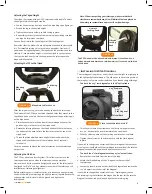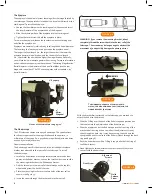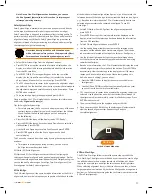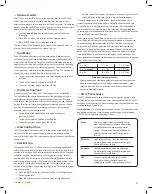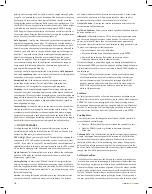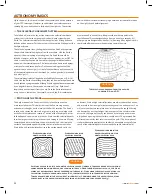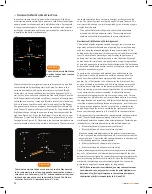
10
>>
www
.celestron
.com
• Don’t worry about confusing planets for stars when selecting
alignment objects. SkyAlign works with the four brightest planets
(Venus, Jupiter, Saturn and Mars) as well as the Moon. In addition
to the planets, the hand control has over 80 bright alignment stars
to choose from (down to 2 .5 magnitude) .
• Rarely SkyAlign will not be able to determine what three alignment
objects were centered. This sometimes happens when a bright
planet or the Moon passes near one of the brighter stars. In situations
like these, it is best to try to avoid aligning to either object if possible.
• For the best possible pointing accuracy, always center the
alignment stars using the same final movements as the direction of
the GoTo Approach (by default this will be using the up arrow button
and the right arrow button) . Approaching the star from this
direction when looking through the eyepiece will eliminate much
of the backlash between the gears and assure the most accurate
alignment possible .
Auto Two-Star Align
As with SkyAlign, Auto Two-Star Align downloads all the necessary time/
site information from orbiting GPS satellites. Once this information is
received, the CPC will prompt you to slew the telescope and point at
one known star in the sky . The CPC now has all the information it needs
to automatically choose a second star that will assure the best possible
alignment. Once selected, the telescope will automatically slew to the
second alignment star to complete the alignment . With the CPC set up
outside with all accessories attached and the tripod leveled, follow the
steps below to align the telescope:
1. Once the CPC is powered on, Press ENTER to begin alignment.
2 . Use the Up and Down scroll keys (10) to select Auto Two-Star Align
and press ENTER .
3 . The hand control will display the last time and location information
that was entered or downloaded from the GPS . Use the Up and
Down buttons to scroll through the information . Press ENTER to
accept the downloaded information or press UNDO to manually
edit the information .
4 . The display will now prompt you to select a bright star from the
displayed list on the hand control. Use Up and Down buttons (6 and 9
on the keypad) to scroll to the desired star and then press ENTER .
5 . Use the arrow buttons to slew the telescope to the star you selected .
Center the star in the crosshairs of the finderscope and press ENTER.
Finally, center the star in the eyepiece and press ALIGN.
6. Based on this information, the CPC will automatically display the most
suitable second alignment star that is above the horizon . Press ENTER
to automatically slew the telescope to the displayed star. If for some
reason you do not wish to select this star (perhaps it is behind a tree
or building), you can either:
• Press the UNDO button to display the next most suitable star
for alignment .
• Use the UP and DOWN scroll buttons to manually select any star
you wish from the entire list of available stars .
Once the desired star is displayed, press ENTER to automatically slew
the telescope to the displayed star. When finished slewing, the display
will ask you to use the arrow buttons to align the selected star with the
cross hairs in the center of the finderscope. Once centered in the finder,
press ENTER . The display will then instruct you to center the star in the
field of view of the eyepiece. When the star is centered, press ALIGN to
accept this star as your second alignment star . When the telescope has
been aligned to both stars the display will read Alignment Success, and
you are now ready to find your first object.
Two-Star Alignment
With the two-star alignment method, the CPC requires the user to know
the positions of two bright stars in order to accurately align the telescope
with the sky and begin finding objects. Here is an overview of the two-
star alignment procedure:
1. Once the CPC is powered on, use the UP and DOWN scroll keys (10) to
select Two-Star Align, and press ENTER .
2 . Press ENTER to accept the time/site information displayed on the
display, or wait until the telescope has downloaded the information
from the GPS satellites .
3 . The SELECT STAR 1 message will appear in the top row of the display .
Use the UP and DOWN scroll keys (10) to select the star you wish to
use for the first alignment star. Press ENTER.
4 . CPC then asks you to center in the eyepiece the alignment star you
selected . Use the direction arrow buttons to slew the telescope to the
alignment star and carefully center the star in the finderscope. Press
ENTER when centered .
5. Then, center the star in the eyepiece and press ALIGN
In order to accurately center the alignment star in the eyepiece,
you may wish to decrease the slew rate of the motors for fine
centering. This is done by pressing the RATE key (11) on the hand
controller then selecting the number that corresponds to the
speed you desire. (9 = fastest, 1 = slowest).
6. CPC will then ask you to select and center a second alignment star
and press the ALIGN key. It is best to choose alignment stars that are
a good distance away from one another . Stars that are at least 40º to
60º apart from each other will give you a more accurate alignment
than stars that are close to each other .
Once the second star alignment is completed properly, the display will
read Alignment Successful, and you should hear the tracking motors
turn-on and begin to track .
One-Star Align
One-Star Align allows you to download all the same information as you
would for the Two-Star Align procedure . However, instead of slewing to
two alignment stars for centering and alignment, the CPC uses only one
star to model the sky based on the information given . This will allow you
to roughly slew to the coordinates of bright objects like the Moon and
planets and gives the CPC the information needed to track objects in
altazimuth in any part of the sky .
To use One-Star Align:
1. Select One-Star Align from the alignment options.
2 . Press ENTER to accept the time/site information displayed on the
display, or wait until the telescope has downloaded the information
from the GPS satellites .
3 . The SELECT STAR 1 message will appear in the top row of the display .
Use the Up and Down scroll keys (10) to select the star you wish to use
for the first alignment star. Press ENTER.
4 . The CPC then asks you to center in the eyepiece the alignment star
you selected . Use the direction arrow buttons to slew the telescope
to the alignment star and carefully center the star in the finderscope.
Press ENTER when centered .
5. Then, center the star in the eyepiece and press ALIGN
6. Once in position, the CPC will model the sky based on this information
and display Alignment Successful .
Summary of Contents for 11007
Page 1: ...InstructionManual 11007 11008 11009...
Page 2: ...www celestron com...
Page 40: ...38 www celestron com APPENDIXD MAPSOFTIMEZONES...
Page 41: ...www celestron com 39...
Page 42: ...40 www celestron com APPENDIXE SKYMAPS...
Page 43: ...www celestron com 41...
Page 44: ...42 www celestron com...
Page 45: ...www celestron com 43...
Page 46: ...44 www celestron com...
Page 47: ...www celestron com 45...







